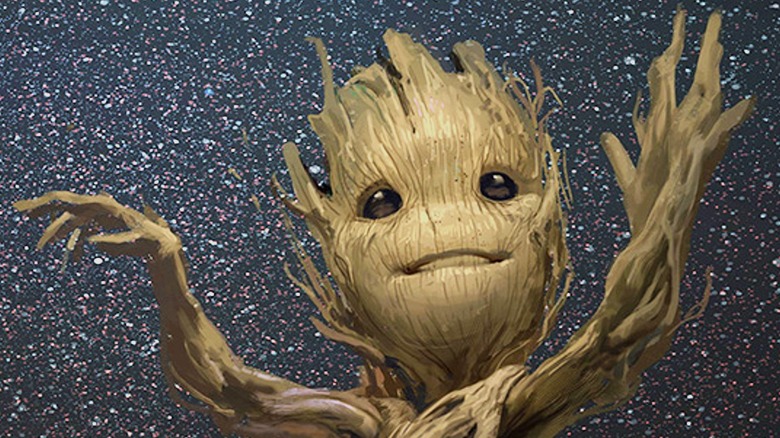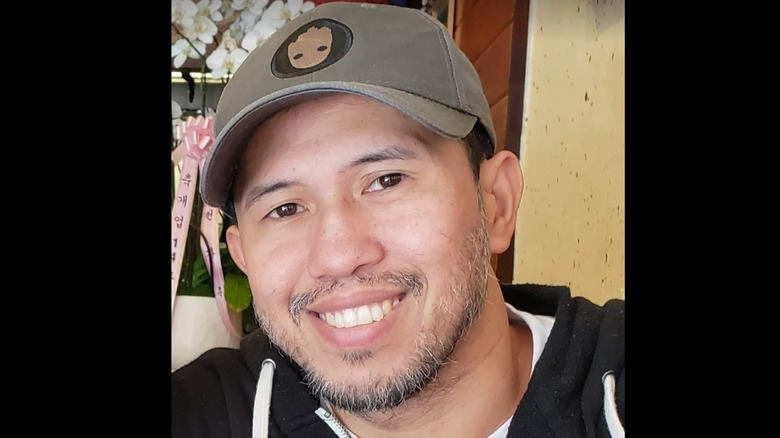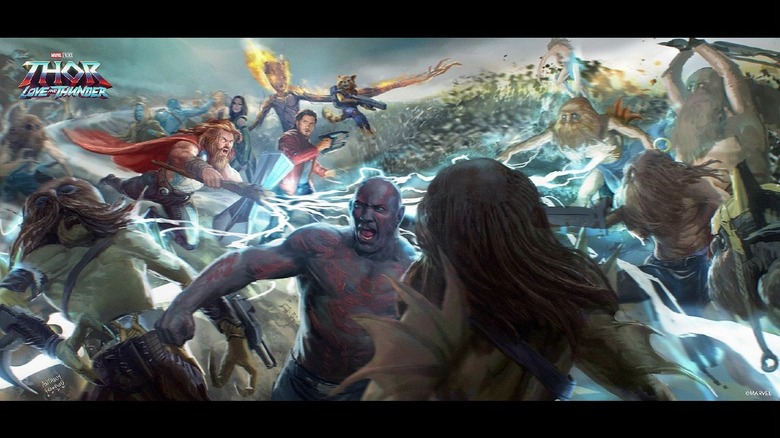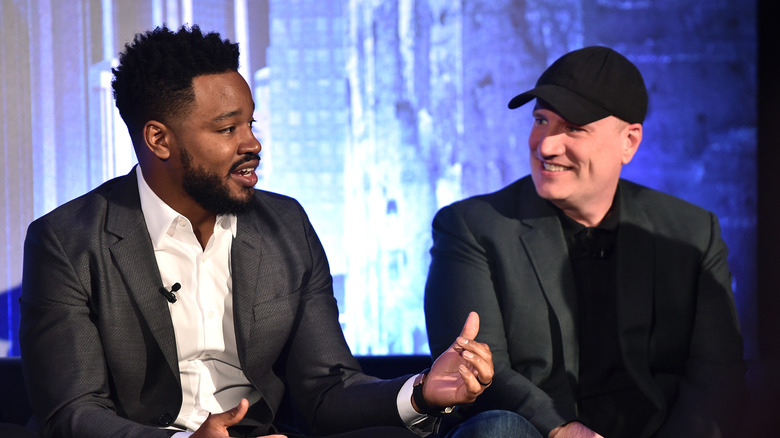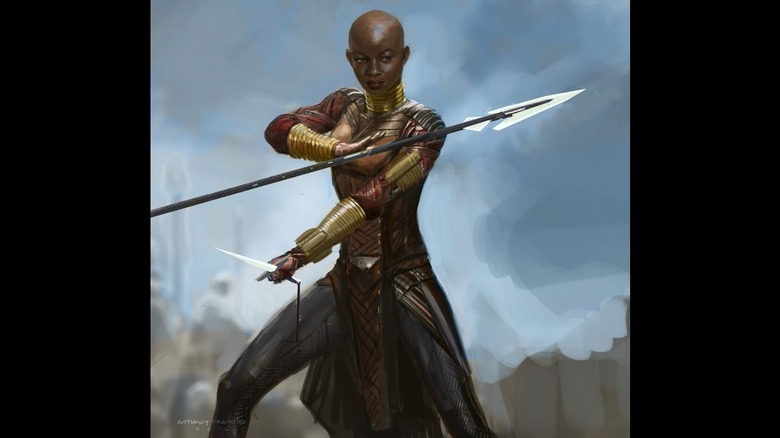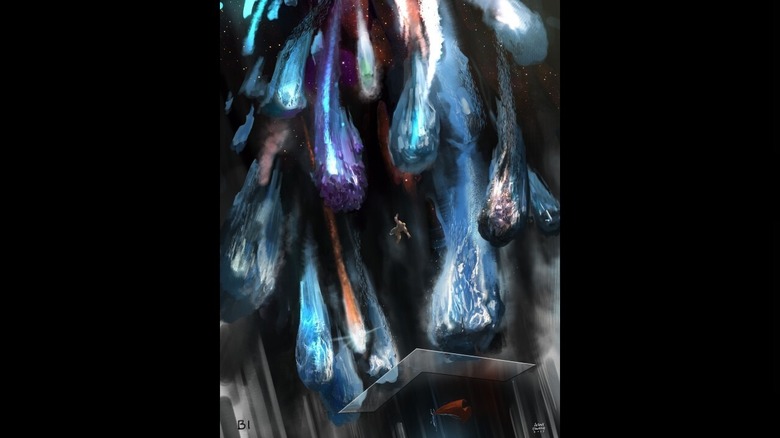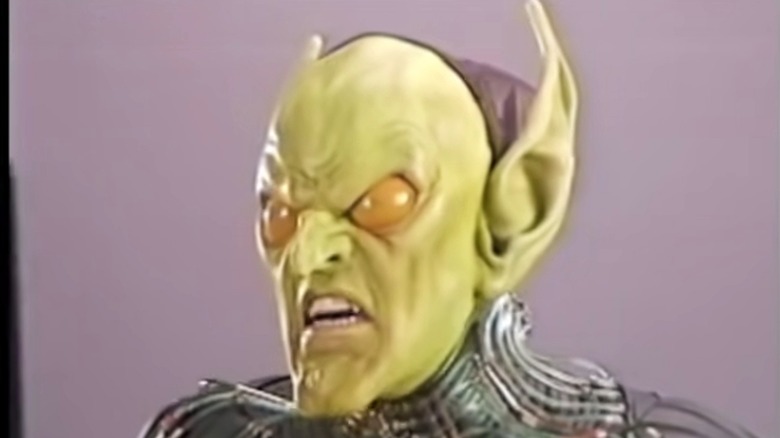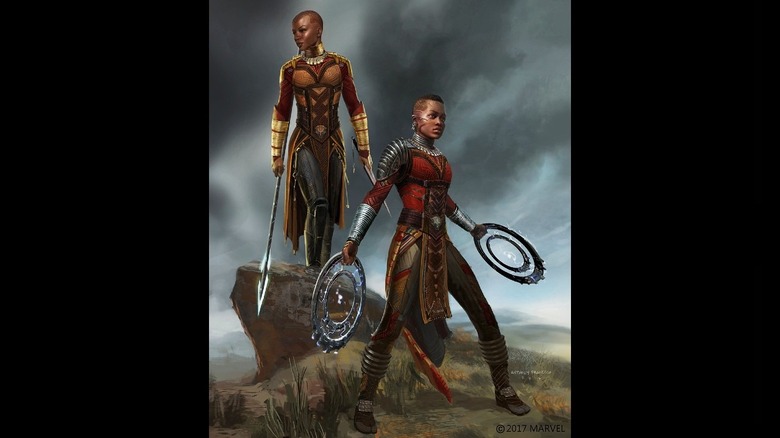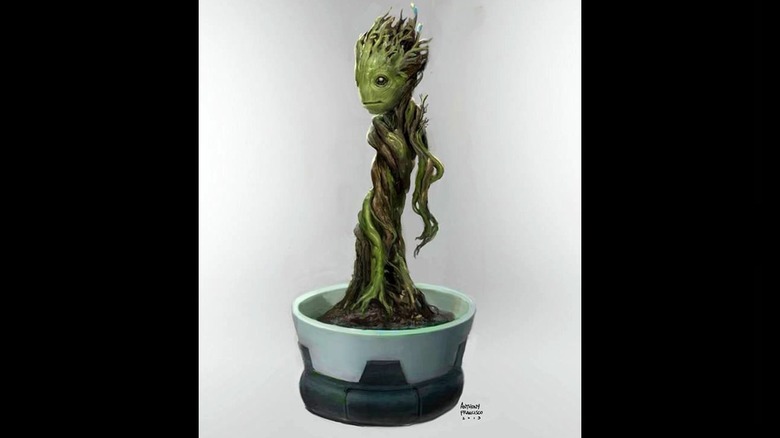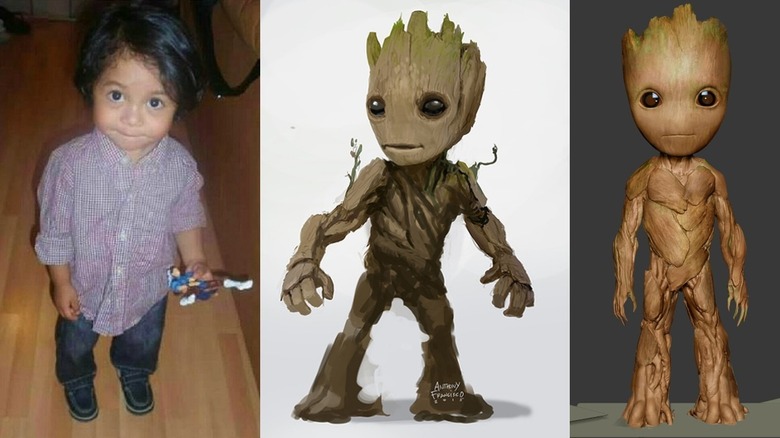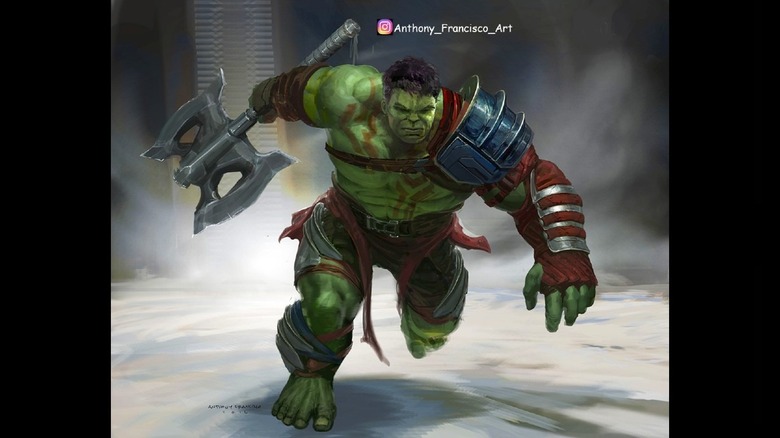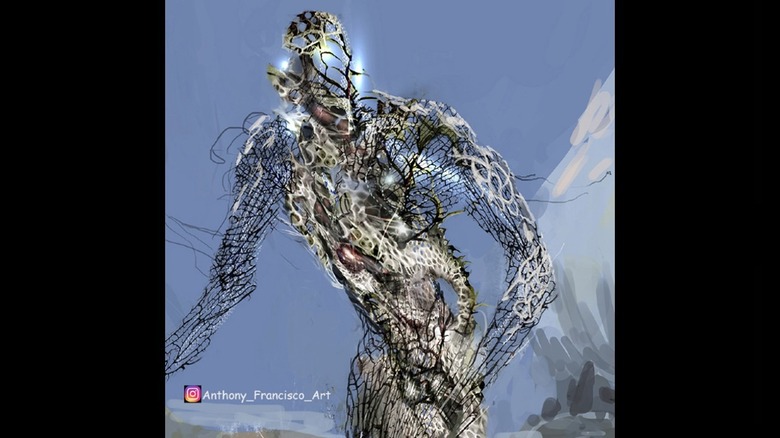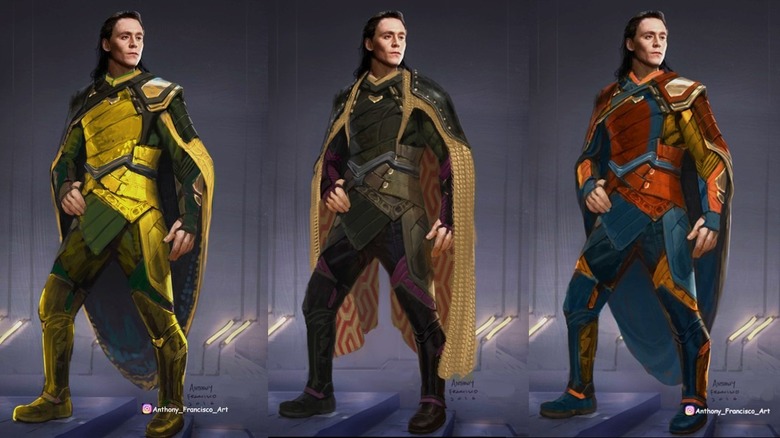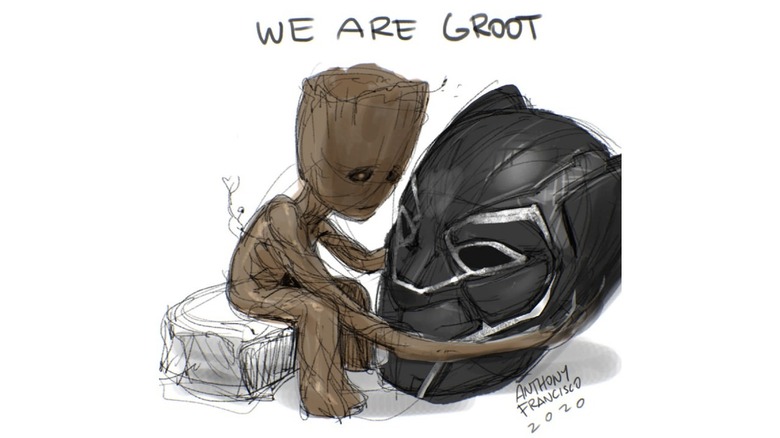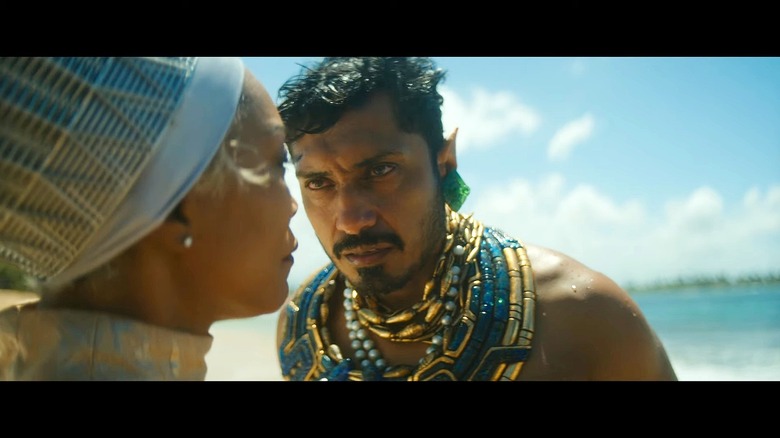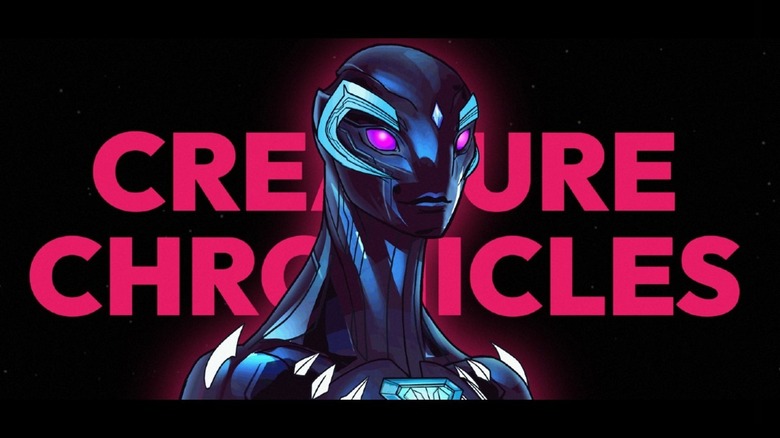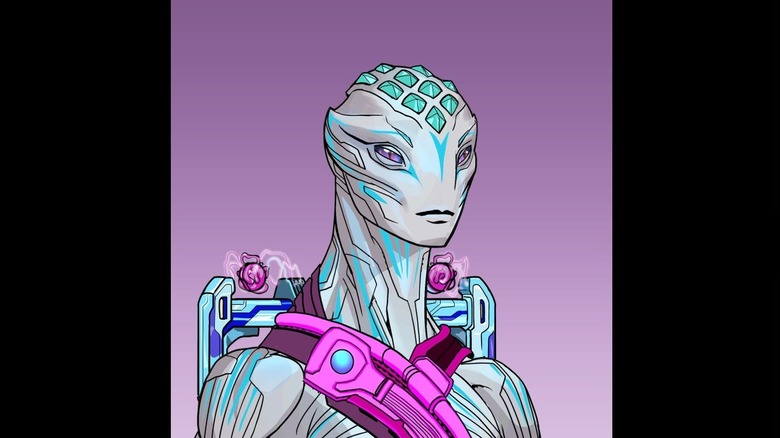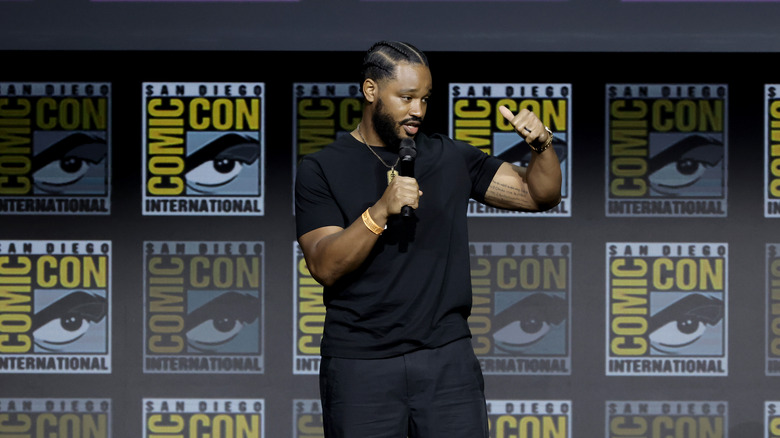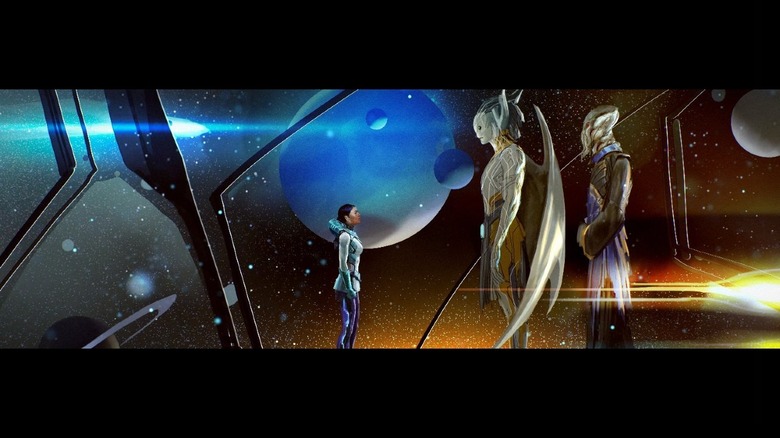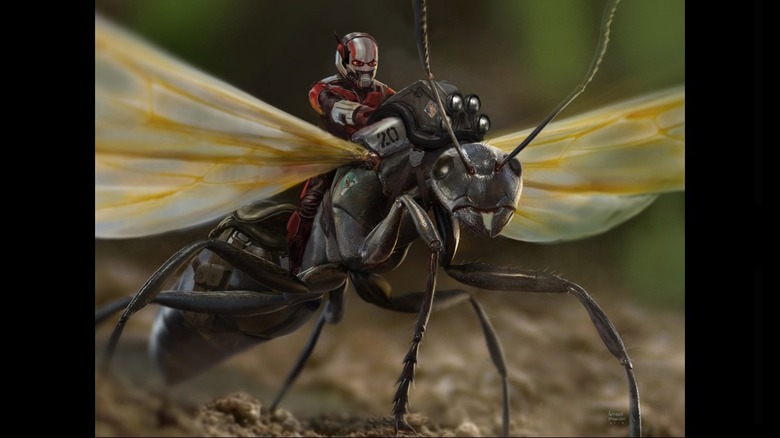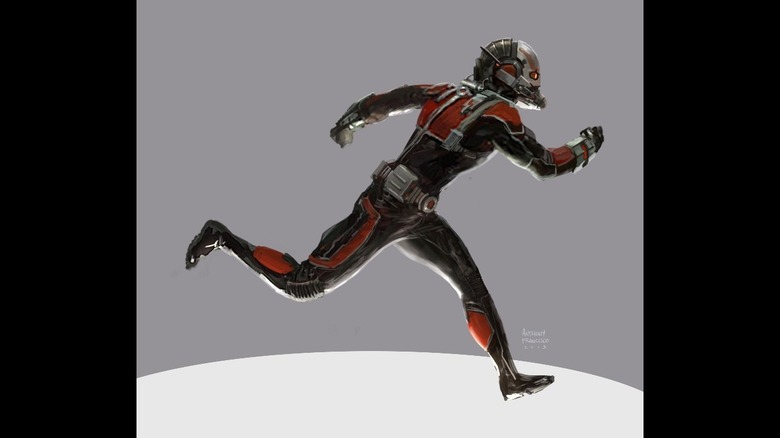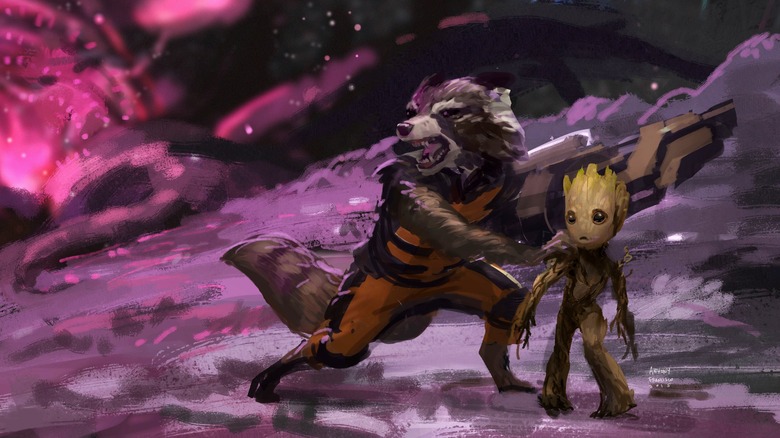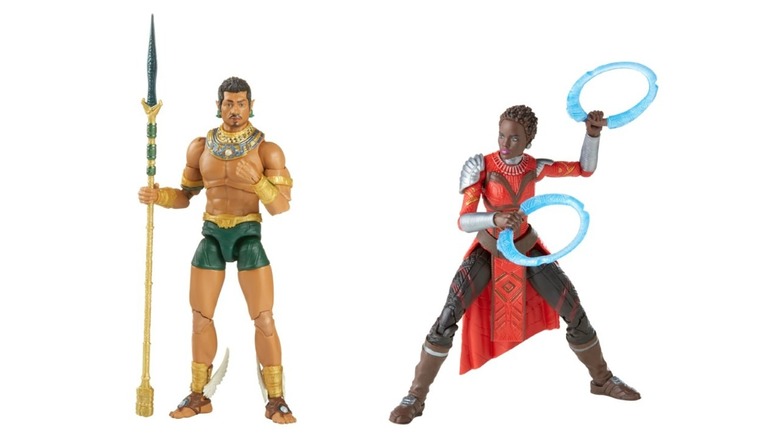Former MCU Concept Artist Anthony Francisco Reveals The Inspirations Behind His Designs - Exclusive Interview
Given the thousands of artists it takes to make a Marvel film, it's hard to imagine what fans are seeing on the big screen all began at some point in time with a single idea. The late, great duo of Stan Lee and Jack Kirby were two of those brains who presented their singular ideas, and together created a multiverse of different stories that is all-inclusive, as well as entertaining and inspiring to everyone who came into contact with them.
Continuing the artistic traditions of Lee and Kirby is Anthony Francisco, who for nearly nine years designed the looks of several key characters in the Marvel Cinematic Universe. As a Senior Artist in Marvel's Visual Development department, Francisco offered his artistic interpretations of several characters in the MCU in well over a dozen films. If you seen any of the "Guardians of the Galaxy," "Thor," "Ant-Man," "Black Panther" or the last two "Avengers" films — to name a few — Francisco's artwork was behind either pivotal characters or scenes in every production.
Sometimes, Francisco's work included redesigning the look of a certain character, like Loki in "Thor: Ragnarok." Other times, Francisco was given the opportunity to peer into own imagination to create the visage of groups of characters like the Dora Milaje in "Black Panther" — in particular, he designed General Okoye — or Baby Groot in "Guardians of the Galaxy, Vol. 2." Making the work even more satisfying, Francisco's creation of the Dora Milaje and Baby Groot enabled the artist to imbue the characters with a personal touch, where he drew inspiration from his Filipino heritage. In the case of Baby Groot, he found he had to look no further than his young son, after whom he modeled the beloved character.
In an exclusive interview, Francisco shares with Looper several details about his career and the filmmakers he worked with at Marvel, as well as his new multimedia creation, "Creature Chronicles." Francisco also delves into the process of his design for Namor (Tenoch Huerta), the legendary Marvel character who will finally make his live-action debut in the hotly anticipated MCU adventure "Black Panther: Wakanda Forever."
Meetings of the minds
I've always been a "credit where credit is due" guy. It seems so much media coverage of film and television productions tend concentrate on the actors, and maybe the directors and the writers, but I like to go a lot deeper than that. At the very beginning of a film or TV production, concept artists are tasked, essentially, with interpreting somebody else's vision for something, which is an amazing thing to me. How do you wrap your head around all of that?
This is why concept artists' jobs are really difficult, because we have to guess what is in the director's head most of the time. It helps if there is reference, but most of these worlds are built from scratch with inspiration from the comic book.
Kevin Feige stays true to the source material and knows what the fans like because he himself is a fan. I would balance trying to get what the director wants while also making sure Kevin feels it is true to the source material before starting physical production. This is so important to save money. This is why the concept artists and illustrators are so important, because we save time and money! They wouldn't want to build it and risk millions of dollars if the idea does not serve the story well.
Do you find that you are kindred spirits with certain directors to achieve the vision together? What you said about Marvel is interesting. That's a testament to why they are so successful. They care about things on the visual development level. They care about hiring somebody who is going to collaborate with you instead of saying, "Here you go."
It's a process and it's hard to get good at it. The kindred spirits idea is correct because sometimes, you get the right director or the right person like the president of Marvel, like Kevin Feige, who loves Marvel stuff, and he hires people who actually love Marvel. I've been a Marvel fan since I was 5, sketching Wolverine, the X-Men, all of that ... When Marvel does it, even with the most recent Spider-Man, they know how to do it right.
That is the testament of how they choose the right cast and the right personalities, and we all mesh together well. In coming up with the visuals for something, a lot of the stuff I've learned when I was younger helps. A lot came from my dreams — and sometimes my nightmares — which are all fused it together. I learned from comic books, too.
Finding kindred spirits
When I mentioned kindred spirits, are there certain directors that you've worked with on a Marvel project where you found yourself more in sync than others? I'm not asking you to say name your favorites or saying, "This director is better than that director." I'd imagine there are some people you gel better with.
So far, there are no favorites — everyone's my favorite for different reasons. I know when I work with Taika Waititi, I have a feel for what would make him laugh. For the most recent movie, "Thor: Love and Thunder," I designed the Booskans, which are the bird-looking characters with beaks. Taika wanted a certain look for them, like a bird. Those are the guys that Thor's going to fight. Then, I did a lineup of characters. The very first one I did, which I became attached to, it's funny. There's a hint of funny to it, but it also looks scary.
I proceeded to do a bunch of other designs that look more bird-like. Taika liked that, and for some reason, I knew he was going to like it because he's a funny guy. He's also very creative. It's the same with James Gunn. There's a cuteness to his stuff that helped me bring out the love for my kids; the cuteness of my kids and this feeling of joy I have.
I put all of that into Baby Groot, who is pretty much my son. He looks like Baby Groot with his eyes. That's how I get my inspiration. Coupled with what I know about the director, I know what works well. With Scott Derrickson for "Doctor Strange," I feel like the whole visual development team gelled with him, and we had the skill to foretell what he would like.
Marvel cares about the characters all the way to the top, Francisco says
In addition to the directors, I would think you have to gel with Kevin Feige because he's the top guy at Marvel Studios. Since you've worked on multiple Marvel projects, I would imagine it's because you and Kevin share the same sort of artistic and creative sensibilities.
Yes, definitely. He is a real inspiration, watching him work or even talking to him, passing by in the corridors in the building and stuff. It's his vision of trying to bring the comic books to life without sacrificing too much of the essence of the characters in the comic books. That's why Marvel's very successful. When we translate the artwork from the comic books to the big screen, I want to always keep that feeling or that look.
Sometimes with my designs, though, I totally change it up. The character might not look like they do in comic book, but you still feel like they belong in it. It's like my design for Namor [in "Black Panther: Wakanda Forever"]. He feels like he does in the comic book, but my design is a whole new take on him ... Director Ryan Coogler had a certain vision for Namor, and Kevin Feige had to approve that look and direction. I was set with the task of figuring out the look of him, including the sea folk — I guess I could call them that ... They're not quite Atlantian. You'll find out in the movie what they are.
Since he's a Marvel fan, Francisco always keeps the fanbase in mind
It has to be a tricky tightrope really to walk. First, you want to interpret the visions of your director. Then you want to honor the looks of the characters in comic book, so you have to have the expectations of those fans in mind. However, since some of these comic books are decades old, you're also faced with interpreting characters' looks that work for the current cultural climate, even though comic book fans want the original version of those characters from years ago. It's so tricky. How do you walk that tightrope to make everybody happy?
That is so interesting. Yes, there is that balance you need to have. Ah, that's such a cool question. I don't think I've ever been asked that. We're aware of that when we're doing the designs. Aside from doing what the fans like, I'm the representative of a lot of fans of Marvel and I grew up with comic books in the '80s. Those stories made me who I am in a way, [teaching me] about honor and being heroic, that kind of stuff.
In the past, even when Jack Kirby and Stan Lee put the stuff together, they were trailblazers. When they first created their characters, there weren't Black characters, and then they made "Black Panther," so he could lead a whole army. Also, look at the way women are leading the Avengers. [Jack and Stan] were forward thinkers from the start. Because of that, I almost feel like I immediately got the essence of the characters I've worked on. Being a fan of Marvel is part of it, and it always seems to work out as long as I do what I feel the fans would like. It's not difficult because that's what I like, too.
The Russo brothers surprised Francisco by using one of his big ideas in Infinity War
Some of the MCU films you've worked on include the last two "Avengers" films, directed by Joe and Anthony Russo. How different is it when you're working with two directors as opposed to one? Did Joe concentrate on one area of production while Anthony concentrated more on your side with the art and the character development or vice-versa? How did that work?
With "Infinity War" and "Endgame," I was actually working on another project at the same time. They brought me in when it came to coming up with some bigger ideas since I am known as "the idea guy" — because I take things a little bit too far sometimes! That's why I'm there, so that I could go that far and then they could bring me back in if they need to. For "Infinity War," the notes and the task I got was to design the battle between Thanos and Dr. Strange, which was a big thing. They said, "We want something epic that we've never seen before."
I came up with a bunch of ideas. [One of my other ideas for "Infinity War"] that really stuck that I didn't know would — because I know the Russos and they like things a little more on the realistic side — was when had Thanos break up the moon and had it rain down [on Iron Man and some of the other Avengers]. That was my idea and they actually put in. I didn't know they put it in until I watched the movie, and I was like, "Oh, my God, they liked it!" In terms of that movie, the big moments are the ones I got to work on, but not all the characters. I technically didn't get to really dive deep into how they maneuver their way through their art. However, I did also come up with the initial idea for time travel for "Endgame."
Francisco got his start working on Raimi's first Spider-Man movie
I see that your first superhero movie work was as a concept designer on Sam Raimi's "Spider-Man" in 2002. What did that work entail, and did you work directly with Sam at any time during the production?
For that movie, I was working at ADI, Amalgamated Dynamics Incorporated. It's a special effects company that worked on the costume for Green Goblin. I worked on the Green Goblin mask most of the time. They had a test where it was not a metal mask yet. It was a mask where the eyes were able to move. It was more like a Halloween mask-type thing. It looked amazing. I was there for that time. Working on Green Goblin was one of my jobs at the beginning of my career, working for Alec Gillis and Tom Woodruff, who were the people that founded ADI. That was where I started working first.
I'm sure it was exciting enough knowing that you're working on the production, but how did you react to Sam's completed film? He took the whole comic book movie concept to an entirely new level with "Spider-Man."
It was an amazing feeling. Seeing Spider-Man finally moving the way Spider-Man should move, I was like, "Wow, I don't even have words" — and I worked on the movie! It was awesome. Some of my work was in the art book, too. Unfortunately, I wasn't accredited in the art book, but the art piece was there because I helped get a certain look for it, and then the art department took over the reins. I can say that I did work on the back of the Green Goblin's head for a while, trying to figure out how the circuits would go through the back of it. It was an interesting take on Green Goblin for sure, which became iconic eventually.
Designing the Dora Milaje for Black Panther is one of Francisco's personal highlights
Of all the MCU projects you've worked on, is there one that really does stand above the rest? It's not that I want you to play favorites here; I'm curious to know what excited you the most from a personal satisfaction standpoint.
I have no real personal favorite. Everything has its own place in my heart. The first film I ever worked on, "Guardians of the Galaxy," is probably my favorite — one, it was because it was my first film; second, it's because I designed Baby Groot ... I feel so lucky that I got to work on all the other films and maintain Baby Groot throughout all of his growth. Plus, he's a representation of my son. When I see that Baby Groot running around, I feel like that's him! It has a good place in my heart.
The Dora Milaje [the group of woman warriors in Wakanda] in "Black Panther," that was an important film for me because it has a lot of things that prove to the world that a Black superhero can make a billion dollars in a film featuring people of color. Designing the most badass women warriors is something I really enjoyed, and I took a lot of pride in that. I put a lot of myself in that design.
Okoye's Dora Milaje uniform is more traditional, so she is more balanced and that is why her design is more symmetrical. However, Nakia's Dora Milaje uniform is asymmetrical with round weapons. I also designed it to symbolize that she is not that rigid and open to new ideas and technology.
Her shoulder piece, which eventually got the nickname "armadillo armor," has a story, too. I wanted to pretend that that piece of technology resembled medieval armor because they would go on outreaches across the world and were given it as a gift, and in turn, they made that piece into a knight's armor. I liked to imagine if Wakanda was the hub of warfare, they also could have influenced the Samurai armor, and this is also why I used that as an inspiration.
The Dora Milaje in the comic books were also scantily clad and I wanted to cover them all up, and I was pleasantly surprised that this is the vision of them that Ryan Coogler had, too. Another feeling I had that was always important to me when designing the Dora Milaje was the great touchstone of African wildlife. The wildlife inspired me because I really wanted these fierce warriors to feel like lionesses hunting in the Serengeti.
The funny influence of Gunn
You mentioned working with James Gunn earlier. Since he's so damn funny, I'm wondering if you feel that the artwork and designs you've created for "Guardians of the Galaxy" films reflect a different sort of quality — or a whimsy, maybe — because of James's humorous approach to the material.
It's funny you say that because when I first read the script, visually in my head it didn't feel like it was really that whimsical. There are moments in the script where it was very emotional, so it felt like an action-drama type thing, and I didn't realize how funny it became but was placed properly throughout the whole movie. I still remember when I designed Baby Groot, James actually came to my desk and said to put the face on a stick. The way he said it was funny. It did lend its the way I designed stuff. I also try to be funny, but I'm not as funny as him! We clicked on that level. Lightness and positive energy clicks with me.
It's like a symbiotic type of working relationship.
I wish I could work with him again outside of Marvel. That would be amazing.
How Francisco's design of Baby Groot was inspired by his Filipino heritage
Sometimes your work involves interpreting another concept artist's thoughts and re-imagining them, like taking the full-size Groot and then finding inspiration for the design of Baby Groot with your son. It's so cool that you modeled that version of the character after him, and also worked in elements of the Filipino culture, including the texture of the Balete Tree. Do you find that your designs are often connect to your personal life in some way, or was Baby Groot's personal touch just by happenstance?
Most of my designs have a touchstone of the Filipino elements that I've grown up with, either visually or in stories. It's always something I gravitate to when trying to get inspired. For Baby Groot, in particular, it was for the textures. I could have used any tree, maybe, but I clearly remember these roots coming down from the Balete Tree and how that actually fits to anatomy a lot better.
You put the plates on top — the little bark plates to cover it up — it was a natural progression from my kid being the inspiration for Baby Groot to elements from the Balete Tree. I'm really happy it came out the right way. I also have to say, watching my kid dance was also an important part of it. When I design stuff, I have to take into consideration the movement of the character, how the form follows function, and how it would work.
When I think about my son at that young age — almost like the size of what Groot could be — he was 3 or 4, was not that tall and moved the way the character moves. It all made a lot of sense. Beforehand, I was trying to imagine other toddlers [to model Baby Groot after], but they were not proportioned like my son — the designs had an awkwardness to them.
[I was saying to myself, I don't think] "they can't dance." I had to make it work because James said, "This is going to be the best opening sequence you would ever get because this guy's going to be dancing around." A lot of my personal experiences and my own culture really helped me with the design.
Waititi's love of Kirby's work influenced Francisco's design of Gladiator Hulk
Talking about Taika Waititi again, even though James Gunn is very funny, I guess maybe you could say irreverent, Taika it seems to me takes things even further. Would that be true?
I could say that. [Both of them] are favorites of mine, and "Guardians of the Galaxy" and "Thor: Ragnarok" were two of my favorite films to work on. I know "Thor: Ragnarok" is Taika's love letter to Jack Kirby, and Jack Kirby has become one of my favorite artists. When I was younger, I couldn't understand how much of an innovator he was, and as I was designing more for "Thor: Ragnarok," I became more inspired by Jack Kirby's work.
I don't know if you know this, but I designed the shoulder pad for Gladiator Hulk. It maintained my exact design, which is a direct inspiration from Jack Kirby's stuff. Even though it doesn't quite look like his work, it inspired the layering and the way it's put together.
I would imagine the fact that you grew up on comic books and eventually worked on comic book movies makes your job a personal endeavor as well.
You said it right. It was full circle for me. The explosion of ideas and creativity came when I first saw my first comic book when I was really young. Then, [around the time] I was 12, comic books were reintroduced to me with the Marvel Universe where I read all the character's origin stories and stuff like that. At Marvel, I was like a kid in a candy store.
[I never thought], "I get to redesign these characters for the film and you're giving me freedom to do it this way?" ... For "Black Panther," I was inspired by the comic book, and in turn, the comic book adapted my design. My design for the Dora Milaje was not a direct translation, it was only the feeling I was trying to capture; the design was inspired mostly from the Dinka and Ndebele tribes of Africa, as well as sprinkles of Igorot and Samurai.
Francisco counts Ego in Guardians of the Galaxy, Vol. 2 as one of his strangest designs that wasn't used
I'm going to ask you to reach deep into the well here because of all the concept art that you've done — all of your character designs — which one turned out to be the most radically different from what you imagined initially and how it eventually looked like on the big screen?
There are a number of characters. One of the big ones was Ego [played by Kurt Russell in "Guardians of the Galaxy: Vol. 2"], because he has a certain type of look, almost like a Buck Rogers-retro pulp comic book-type look. It went from that to more of plant-like look to, "Or is he the whole planet?" Once we found out who the actor playing him was going to be, that's when things got a little bit clearer.
I also did some cowboy-looking versions of him and one with a sailor feeling, because he sails across the universe, right? Every design has to have that kind of background. I was thinking he was like Han Solo, so I made him look like a space cowboy. In the end, he looked more like a spaceman, I guess. I can't even explain it, but it seems very drastic. It took eight months to slowly get to the point where we were running out of time and we had to decide. James Gunn had to decide.
Loki's look for Thor: Ragnarok underwent radical changes, Francisco says
Are there any other crazy MCU character designs that didn't make the final cut?
I'm thinking of another one that really changed a lot — Loki in "Thor: Ragnarok" started off looking like a Viking, because Taika Waititi really wanted him to feel more masculine and more modeled after Norse God mythology. I had fur on him, and he looked like he was a warrior and not as androgynous looking. We ended up with him looking like he did in Sakaar and still keeping some elements from Asgard.
It was amazing that I got to design him brand new, because [Marvel's former head and co-founder of Visual Development] Charlie Wen had an amazing designer for Loki previously, and that was worrying me a little bit because I had to design Loki's look for "Thor Ragnarok." Since Taika said, "I want a brand new one," I went ahead and it was awesome. I'm glad that he allowed me to do that.
Loki had a lot of wild designs with different colors and I published some of them on my Instagram account. There's the banana suit one where the costume is yellow, and then there's one where it's multiple colors, but I don't think I put that out. It's really terrible because I was trying to do something different with it. For the new "Marvels" movie coming out, there's some stuff I did for that's really interesting, but it didn't end up being used. I can't wait to show that, though, because it's really out there in terms of Marvel's aesthetic.
Are there any other hallmark MCU character designs that you wished you could have worked on?
Yes, because sometimes we'd walk around or we inspire each other by looking at each other's work and sometimes you're like, "I really think this could help this" or "I have another vision of it." Sometimes, when visualizing an outcome, if you believe in that kind of stuff — where you ask the universe and visualize it — the next thing you know you're doing a name design and it gets approved.
A tribute to T'Challa and Chadwick Boseman
I was touched by the sketch on your Instagram account of Baby Groot holding T'Challa's mask, conveying how much he misses the Wakandan king after Chadwick Boseman passed away. The post included your comment, "I miss him so much." I looked at that sketch and thought, "That's art with heart." Do you invest yourself emotionally in everything you do?
That sketch came about after he passed away. It really hit me hard and then I had to draw and paint it to pay tribute ... It becomes really emotional sometimes, because you put yourself in it a lot, and then you see actors who champion certain ideals and are breaking new ground, and being that kind person while they're doing it. That really touches me.
There's stuff that happens within the industry that's difficult because you put all your heart into your designs and sometimes you're not given the proper credit or someone's taking credit from you. That's hard because with me, when I do my designs, I put a lot of myself in them and maybe I've been developing these shapes for 15 years and it all culminated in that one design. The Dora Milaje from the Black Panther or Namor [from "Black Panther: Wakana Forever"] — almost all of them have stories behind it.
It's very tiring sometimes when you really get into it. I don't know how other artists handle this; I speak for myself when I say I really get into it. Even the research that's involved and what I've learned through designing the Dora Milaje and Namor [were] really emotional to me. Especially because I'm a person of color, seeing what happened in the world and [the adversity they endured in the] civilizations they came from affected how I designed these characters. When it comes time to see what I designed represented on screen, it gets really emotional for me.
I would imagine some of the imagery in "Wakanda Forever" will be there to honor Chadwick Boseman. Will fans be able to see that, to feel that, when they watch the film? He was such a charismatic actor that I'm sure his presence is going to be felt regardless.
For sure. In the trailer, you already see tributes to him with paintings on the walls. When he first passed, they even changed the trailer for the title to have his images in there. I can't say too much. Once it comes out, then you'll see even more of it. There'll be exciting stuff everyone will get to see. It definitely will be emotional.
Diving into the design of Namor
Since "Black Panther: Wakanda Forever" is coming out soon, is there anything in particular you designed for it that you're excited for people to see?
I would say it is going to be a really emotional journey and a lot of cool action, as well as some reveals. I can't talk about what the story is going to be, but I'm glad that [images of the] costume of Namor finally came out and I can actually talk about parts of it ... I was researching Mesoamerica and the different civilizations that came after each other: The Mayans, the Olmecs, and the Aztecs ... I looked through a lot of folklore, documentaries on Mesoamerica, and information about their gods and things like that.
What you'll see in the design is a celebration of the culture of Latin America and Mexico. It is really a treat to be able to design for that, and that's true to form with the way I do designs. I have the main 80% of it being the vision, the aesthetic of Mesoamerica.
How do you get in the headspace of a culture when you are formulating a design?
I was pretending I was a graffiti artist in that time, where they had the glyphs. I learned so much from those glyphs while trying to understand them and reading about them through the research. I saw how they would explain their stories. I know Marvel wanted the design to look Mesoamerican, so I designed the necklace to look original, by pretending I was there [in that time period].
I designed something that looks like it's from there but it's not ... They wanted something that looks like it was from there but not historically accurate. That way, we won't step on anyone's toes and make people upset because it was all made up. I pretty much made up the whole design.
The birth of Creature Chronicles
Let's take a break from the Marvel stuff and talk about "Creature Chronicles." I love everything about this. As I said earlier, I'm "credit where credit is due guy." I love the mission: a community of artists, a goal to support other creators of fan fiction. It's great that you're involving people who don't quite get the recognition or the compensation, quite honestly, that they deserve. Would that be a correct assessment of your mission of "Creature Chronicles"?
Yes. Getting into Blockchain, Web3, and NFTs, what really caught my attention was the way artists are able to earn royalties multiple times after their artwork is sold and not just the one time they sell it. I felt like, "That's what we needed," because a lot of the stuff has gone to digital and a lot of the commercial work is digital. If you can sell an original thing you did for a job, then it would help you have a better living.
That's what got my attention, and I started thinking, "Is there a way for that to help concept artists?" [The idea is], if there's a group of concept artists that did artwork for bigger companies, whenever the bigger companies use it, they would get paid royalties like voice actors, like writers, like anybody else. Most of the workers below the line don't get that. I am hoping for the ones who are really close to a project, like the Marvel Visual Development team — the ones building what the MCU looks like — maybe there's a way for very talented artists to get some royalties from what they've created.
Getting Creature Chronicles up and running
The great thing is you're leading a band of creatives, and on top of that, you have real support with some titans — public relations titans — with Dolphin Entertainment. They're at the top of the industry with big name clients and they're great at promoting great talent. How did "Creature Chronicles" attract the attention of such of a prestige organization?
I have to give the credit to my manager, Kevyn Morrow. He totally believed in me and my ideas that I have. I have 16 ideas — IPs that I'm trying to make — and I have eight in the pipeline and three that are done already, and others that are slowly being pitched around. I have been able to pitch it to different places already and they actually enjoyed it. Because of the pandemic, things slowed down, and that's where Kevyn met the CEO of Dolphin, Bill O'Dowd, and they got along. He mentioned [to Kevyn that they] wanted to get into the NFT space, and [Kevyn said] I was also getting into the NFT space.
When I met Bill — he's such a sweet guy — we got along really well ... He liked my personality, my positive energy and attitude, and he felt the shows I mentioned to him could potentially get big, and one of the ideas was "Creature Chronicles."
Francisco says Coogler inspired him to pursue his dream
When did the idea for "Creature Chronicles" come about, and when did you decide to put it into play?
I actually created "Creature Chronicles" before I went to Marvel. It was sitting for a while until I was talking to Ryan Coogler at a dinner at a pre-Oscar party or something. We were talking, and he loved that I put some Filipino elements in the Dora Milaje, and he kept on encouraging me, "Don't forget your dream." ... When he said that to me — he's such a young guy with a lot of energy — it inspired me to think, "Yeah, don't forget my dream. I don't have much time in this world. I should go for it now instead of waiting."
I had so much fun at Marvel that I forgot for nine years that I had this other goal, and I had to take the risk and jump and do it. Kevin Feige was congratulatory. He is such a supportive guy, and he said the door is always open if I ever want to come back. Hopefully, I can come back as a director.
How does the "Creature Chronicles" multiverse approach differ from what the MCU and DC are doing?
My favorite movies are "Alien" and "Predator." Those are the ones I really love. With "Creature Chronicles," I was thinking of how space is so vast, and I know I love science, that maybe this could be the way to set a multiverse up by pulling from my Filipino roots — where 7,100 islands in the Philippines is the place that seems to be the birth of the universe. Each of these islands have their portals into the different worlds you would be in, and the Etrigans, who manage this place, are being hunted by this other alien race when things go awry.
We'll get to the story once the series comes out, but that was one way for me to make this big universe so I could accommodate all the other styles of writing, and artists and fan fiction of "Creature Chronicles."
I'm hoping that this could really help other artists, and that setup was perfect because then each island could have horror here or sci-fi here, or adventure here. You go through those portals and it's like my own Marvel Universe, like the comic books. I'm trying to follow the steps of Jack Kirby and Stan Lee, and Dolphin has become the hub for that. They're great because they have reach into different industries and are a PR powerhouse. Now, we're really talking about our NFT, which minted on October 2. "Creature Chronicles" original IP, backed by Dolphin Entertainment, sold out its 7,777 PFP [profile pic project] collection in a little over an hour!
There are no boundaries for Creature Chronicles, Francisco says
I'm certain comic books has to be part of the plans for "Creature Chronicles." What else are you thinking of? An animated series or maybe an animated film? Is there anything off-limits for "Creature Chronicles"?
Nothing is off-limits, really. Bill O'Dowd really wants to see it a story. So, at first it was more of a story for an animated series, then it was live-action, then animated because live-action is just too epic, too expensive; so, I thought, "Let's go baby steps first." Even though we're releasing it as an NFT, the NFTs are an introduction to the world.
Eventually, every season there will be new characters introduced. Before we were minting, last year when I first started at Dolphin, we already started developing the script. They partnered me up with a writer, Brian Herwitz, who is an amazing guy. I love working with him. He is helping me develop this whole thing. We have outlines approved to create the pilot script, a bunch of storyboards, visual development designs, and environment designs.
It's me and a producer and the writer putting this together at this point. We're going to branch out and start deciding who's going to be in it, who's going to voice it, and it would be amazing to get people from the community.
Francisco says he was in-the-know from the start of his projects in the MCU
Back to Marvel. Details for their projects are kept under a tight lid, so even some of the actors don't know any more than what's on the pages they're given. How integral were you as a visual development person to the details of any given project? Do you know everything that's going on and how the story will end from the start of a project?
I would say because of the script, you would know, right? It's spoilers galore!
You're given the whole script up front?
Yeah, but I also knew who the characters in "Guardians of the Galaxy" were because of the Marvel Universe comic books. Generally, in terms of directors, we probably know more of the characters than the directors would know coming in. If they're not comic book buffs, then they'll have to research the characters. Some of them know their stuff off the bat. I'm sure when they meet with the production executives, like Kevin Feige and Victoria Alonso, they would already be talking about that. In terms of knowing spoilers and stuff, we would pretty much know it all already, even though it changes [throughout production].
Another great thing about the work at Marvel is that as the Visual Development team, we design all the characters — all the heroes and villains — but we also design the key frames, which turn into actual moments in the film. Sometimes, there's no script yet, so we would be asked to do whatever you think is cool with these characters and that's when it is really fun.
One of those scenes — the briefcase fight in "Ant-Man" — the script said, "briefcase fight" and then I had to take care of that. Charlie Wen, the guy who hired me at Marvel, the co-head of Visual Development, told me, "All right, it's just a briefcase, you handle it, Anthony. Do whatever you want." That was amazing. Since it was my first time, I was nervous. I thought, "Whatever I want? How will I know?"
This is where I'm feeling really happy thinking about this right now — thinking that moment happened — because it was my choreography that I put in it, the phone in it; I became a production designer within that little briefcase and everything they put on screen. They loved it so much and made sure I knew about it.
There was the scene with sugar water being fed to the ant, right? That was one from my key frames. My sister knows the editor, Dan Lebental, and Dan would tell me that they had that frame on their studio notes to remember it was a scene that people liked that was not in the script. They had to had to change the script based on my illustration.
Big excitement ahead for the next Ant-Man movie
One other Marvel project that you've worked on is coming out with "Ant-Man and the Wasp: Quantumania." Is there anything that you can say about your work on the film, as it relates to your work on the first? Do you feel like, "Wow, this story has really taken a step here? I can really feel it."
It's definitely something really big. They just announced during a Comic Con, they did talk about Kang the Conqueror. They had the actor [Jonathan Majors] come to the presentation. I got to work on him, design some of him. I didn't get the final design, but it was so much fun working on him and his other looks, and it is going to be more epic than a normal Ant-Man movie is going to be.
I could probably say this: I designed M.O.D.O.K. for this ... It's a huge, and I know they said this during Comic Con, right? I designed him and oh, my God, that's one of the best experiences. It was so fun because he's one of my favorite characters that I would draw when I was younger, with him fighting Incredible Hulk. That's what I used to draw ... They knew I was going to do justice with the [way the character was presented in]comic book. Kevin Feige really liked the takes I had on him and I can't wait to show it.
How exciting was it working with Destin Daniel Cretton on "Shang-Chi and the Legend of the Ten Rings," especially since the film was a landmark film for the MCU in regard to Asian representation?
It was really exciting working with Destin, and I am lucky enough I got to meet him and talk to him. I understand more why representation is so important because seeing someone like him succeed lets me know that I can possibly do the same thing.
Celebrating a dream come true
"Guardians of the Galaxy: Vol. 3" is coming up, which I know you did some designs for. How do you think James Gunn's filmmaking sensibilities have changed from the first film to the third film? A goal of any great artist is to grow and evolve with each piece of their work. Have you sensed that at all with what James has done from the first film to the upcoming third film?
James Gunn always has his style and that is that he really a strong voice. I can't really say too much about the project aside from the stuff that's already gotten out there. There's some surprising stuff ... that was my last project at Marvel and it's very interesting that it ends his "Guardians of the Galaxy" movie series.
Since James Gunn has said, too, that this is it for the iteration of these Guardians, are you going through a mourning period already since this project — particularly with Baby Groot and Teen Groot — since they are a reflection of your personal life?
That's true. Because of the fast pace of work — we're on two to three projects at the same time — there's no time to mourn until you watch the movie and see how everything comes together. That is the conclusion period with every show, but you move on to the next one. I think about how it was an end to an era when Iron Man passed away [in "Avengers: Endgame"]. "Endgame" became like the "end" for me. It felt like that. Then, there's a new beginning with the series on Disney + ... I worked on a few of those too [including "WandaVision"].
It was a hard decision to leave Marvel even though I had this opportunity to do my own IP. I almost wanted to do the stories within the Marvel Universe, even though they're not my characters, but my stories could be there. I wanted to see how far I could get within Marvel.
Certain things didn't work out the way it should have been, and then I got opportunity with "Creature Chronicles." It was great timing because now there's a new experience I can have and then start building another skill set of directing stories and even producing. That's a new adventure for me and hopefully, and we're off to a good start with "Creature Chronicles."
I'm about to also direct my first short film. It deals with Filipino folklore and my two kids. They are all inspirational things for me. My kids are going to be in my film. It's funny. I wanted to see them be together and act, and it's going to be exciting. There are a lot of cool people on board for this one. That's what I'm going to share with everyone once it's done.
Am I mourning the loss of something? The cycle still goes through and I'm like, "I appreciate the time I have on Earth and I want to make sure I make the best of it." I try not to mourn too much.
Just celebrate.
Celebrate. Yes.
Francisco is proud with the way with designs live on in different forms
I noticed all the cool collectibles of characters you designed in the background. As a big action figure fan, I will say the Hasbro Marvel Legends action figures are pretty impressive now. They're so detailed. To have a 3D representation of some of the stuff that you've done with Marvel like Namor and the Dora Milaje must be really, really cool.
It is, to have my design as a collectible toy. When I was younger, I collected "Star Wars" collectible toys and stuff and to think that my designs like the Dora Milaje, how everyone's cosplaying it and people know what is, they don't know I designed it, but some people do know — is what's awesome. I have the pride in knowing I've done that.
Now you'll have pride in knowing you designed Namor for "Wakanda Forever."
I remember the inspiration for the symbolism I put into his costume that you see on the necklace, because it's out now. You actually see my design. That's an original design. It's not copied from anywhere. It was taken from a dream [after I watched documentaries about Mesoamerica]. I was dreaming about, "How am I going to represent Namor? He's life and death, and they say he gives lives? What kind of god do they see in him?"
The feathered serpent — Kukulkan — is the one I was thinking of. He became my inspiration. That inspiration, coupled with technology, made me think, "How do I put technology together with the folklore and the gods into what Namor is, and the civilization underneath?" I came up with a bunch of ideas to show it, and the relationship with the ocean and with the animals, and these different, crazy ideas that they actually started using. Ryan Meinerding, the head of Visual Development, told me that I "carried a lot of the weight" — I did "a lot of the heavy lifting."
"Black Panther: Wakanda Forever" is in theaters November 11. In addition to his work on "Creature Chronicles," you can follow Anthony Francisco's work at his website, as well as his Twitter and Instagram accounts.
This interview was edited for clarity.
